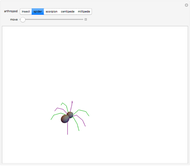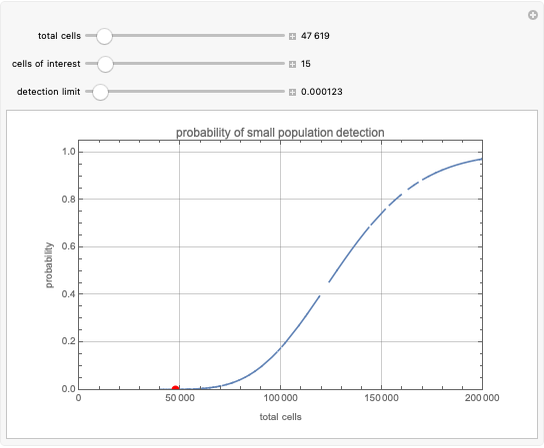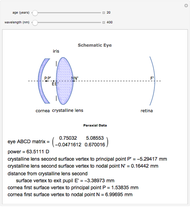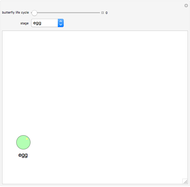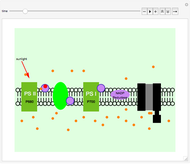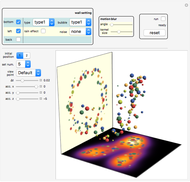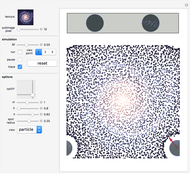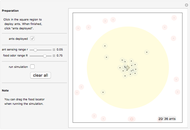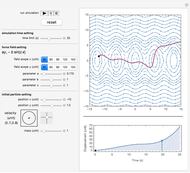Simplified Social Amoebae

Requires a Wolfram Notebook System
Interact on desktop, mobile and cloud with the free Wolfram Player or other Wolfram Language products.
This Demonstration builds a simplified social amoebae model and simulates their behavior. Before running this Demonstration, we recommend you watch the companion movie to [2].
Contributed by: Yiyang Li (May 2011)
Open content licensed under CC BY-NC-SA
Snapshots
Details
Background
Being able to provide clues to the development and evolution of all living things, social amoebae [1], or cellular slime molds, have been widely studied for decades, as they can form a multicellular organism that has a remarkable ability to move and orient itself in its environment while maintaining a sophisticated division of labor. A vivid description of cellular slime molds is presented in the review of the book [1] by Danny Yee: "Cellular slime molds are single celled amoebae that live in the soil, where they eat bacteria and reproduce by fission like other amoebae. When they run out of food, however, they aggregate into large 'slugs' which crawl upwards to the soil surface, where they develop into fruiting bodies with spores raised above the ground on a stalk, for dispersal by animals." Such collective behavior (see the movie made by [2]) has been attracting constant attention for many years [2, 3].
Algorithm
In this Demonstration we do not yet intend to simulate the sophisticated collective behavior of social amoebae, but present some simplified behavior. The algorithm is described in the following steps.
1. At the beginning, 
 amoebae with length
amoebae with length  and nFS
and nFS  food sources with radius
food sources with radius  will be distributed at random within a square region with side length 1. Food sources are fixed; as there is a fixed minimum distance among them, it is not recommended to set the quantity of food source too high if you would like to modify the code. All amoebae will try to move to link to a food source but their movement will not cross the region's boundaries during simulation. Once an amoeba links to a food source it will stop moving and become a fixed amoeba. A fixed amoeba can act as a tube and transport food to other amoebae that link with it. However, food sources have a load limit
will be distributed at random within a square region with side length 1. Food sources are fixed; as there is a fixed minimum distance among them, it is not recommended to set the quantity of food source too high if you would like to modify the code. All amoebae will try to move to link to a food source but their movement will not cross the region's boundaries during simulation. Once an amoeba links to a food source it will stop moving and become a fixed amoeba. A fixed amoeba can act as a tube and transport food to other amoebae that link with it. However, food sources have a load limit  , so only up to
, so only up to  amoebae can link to a food source. When this limit is reached, any new requests of amoebae for linking to this food source will be rejected. Amoebae have unlimited lifetime.
amoebae can link to a food source. When this limit is reached, any new requests of amoebae for linking to this food source will be rejected. Amoebae have unlimited lifetime.
2. Any amoeba can link to a food source by a direct link or indirect link. A direct link refers to the case when the distance  between the center of a food source
between the center of a food source  and the center of an amoeba
and the center of an amoeba  satisfies
satisfies  ; whereas an indirect link refers to the case when
; whereas an indirect link refers to the case when  but there is at least one fixed amoeba
but there is at least one fixed amoeba  and the distance
and the distance  between the centers of these two amoebae satisfies
between the centers of these two amoebae satisfies  , where
, where  is a parameter and it is set to 0.8 in this Demonstration.
is a parameter and it is set to 0.8 in this Demonstration.
3. Every amoeba has the special ability that at each step it can sense the approximate positions of all food sources. That is, if a food source  is located at
is located at  , then an amoeba
, then an amoeba  will sense its position as (
will sense its position as ( ,
, ), where both
), where both  and
and  are pseudorandom variates from the normal distributions
are pseudorandom variates from the normal distributions  and
and  . We call these sensed positions virtual targets.
. We call these sensed positions virtual targets.
4. When the simulation starts, each amoeba  can sense
can sense  virtual targets. The probability
virtual targets. The probability  that the
that the  virtual target being chosen by
virtual target being chosen by  as its actual target that it will move toward at this step is determined by the distances
as its actual target that it will move toward at this step is determined by the distances  between the
between the  and the
and the  virtual targets, namely,
virtual targets, namely,
(1)  .
.
So the nearer the virtual target, the higher probability it has to be chosen. As the simulation continues, some food sources may become fully loaded. If food source  is fully loaded and an unfixed amoeba
is fully loaded and an unfixed amoeba  comes to link to it, then
comes to link to it, then  will be rejected. Every amoeba has its own memory (a rejection record) that records the times it has been rejected by every food source. Therefore, if
will be rejected. Every amoeba has its own memory (a rejection record) that records the times it has been rejected by every food source. Therefore, if  is rejected by
is rejected by  then at the next step the probability that
then at the next step the probability that  still chooses
still chooses  as its actual target will be halved,
as its actual target will be halved,
(2)  ,
,
where  denotes the number of times that
denotes the number of times that  has been rejected by
has been rejected by  . Supposing that
. Supposing that  of the
of the  food sources are fully loaded, then the probability that amoeba
food sources are fully loaded, then the probability that amoeba  will choose a different food source
will choose a different food source  as its actual target is determined by
as its actual target is determined by
(3)  .
.
Equations (2) and (3) ensure that after a few repeated rejections by food source  and after the completion of the current
and after the completion of the current  -step process (see step 5), amoeba
-step process (see step 5), amoeba  will then leave
will then leave  and try to link to other food sources, even though it is actually in the vicinity of
and try to link to other food sources, even though it is actually in the vicinity of  . If amoeba
. If amoeba  records that it has been rejected by all food sources, then all its probabilities will be determined by equation (2) (in this case we need to re-normalize the calculated probabilities so that for any
records that it has been rejected by all food sources, then all its probabilities will be determined by equation (2) (in this case we need to re-normalize the calculated probabilities so that for any  we have
we have  ).
).
5. Once a virtual target is chosen by an amoeba, it will lock its attention on this specific food source that is related to the chosen virtual target for  steps. In other words, during the next
steps. In other words, during the next  steps this amoeba will keep sensing and moving toward the approximate position (which may still be different at different steps) of this food source only, paying no attention to other food sources, no matter whether it is rejected by this food source or not. After
steps this amoeba will keep sensing and moving toward the approximate position (which may still be different at different steps) of this food source only, paying no attention to other food sources, no matter whether it is rejected by this food source or not. After  steps pass, if this amoeba still does not link to any food source, it will repeat steps 4 and 5.
steps pass, if this amoeba still does not link to any food source, it will repeat steps 4 and 5.
References
[1] J. T. Bonner, The Social Amoebae: The Biology of Cellular Slime Molds, Princeton, NJ: Princeton University Press, 2009. [2] T. Gregor, K. Fujimoto, N. Masaki, and S. Sawai, "The Onset of Collective Behavior in Social Amoebae," Science, 328, 2010 pp. 1021–1025. [3] C. M. Waters and B. L. Bassler, "Quorum Sensing: Cell-to-Cell Communication in Bacteria," Annual Review of Cell and Developmental Biology, 21, 2005 pp. 319–346.
Permanent Citation







